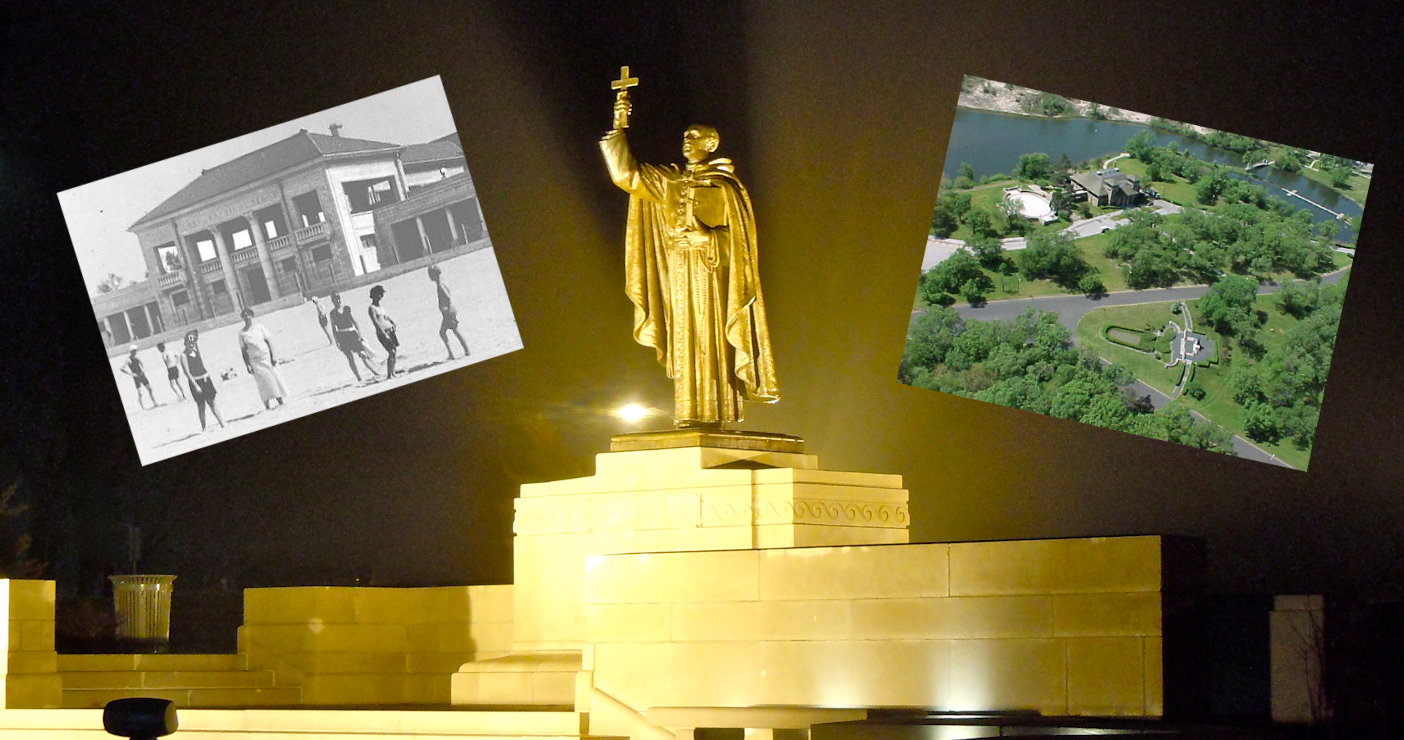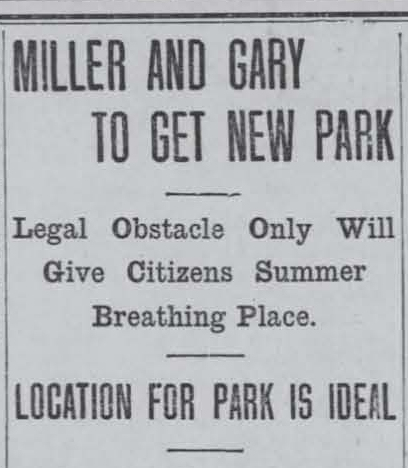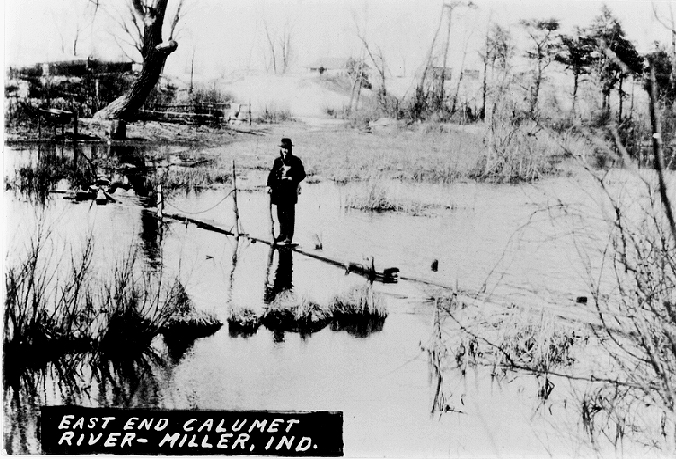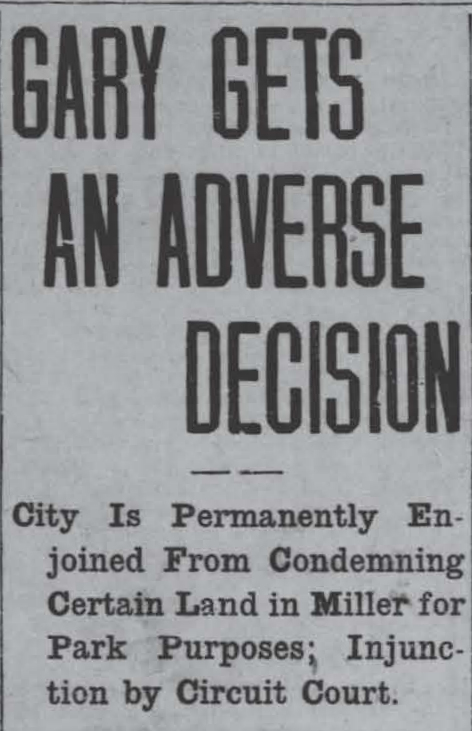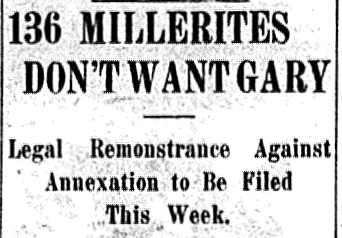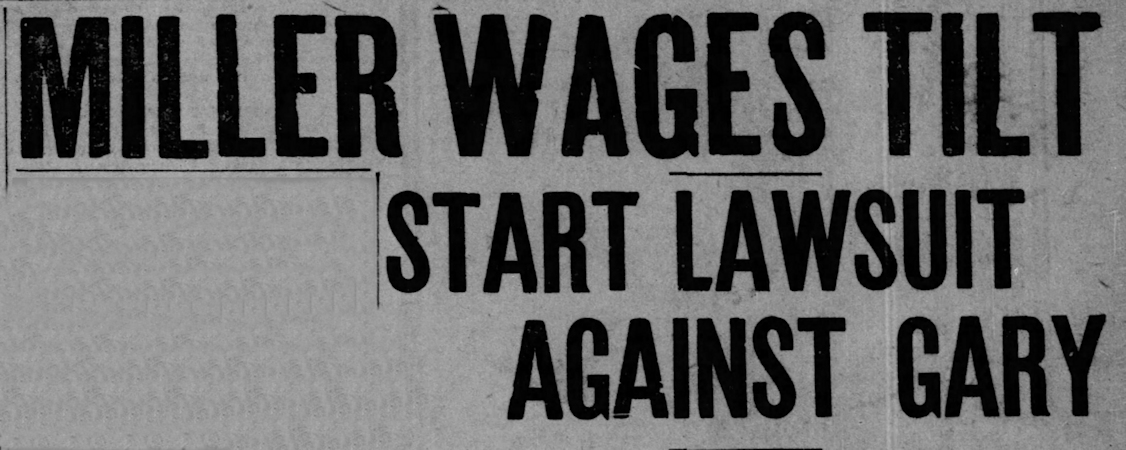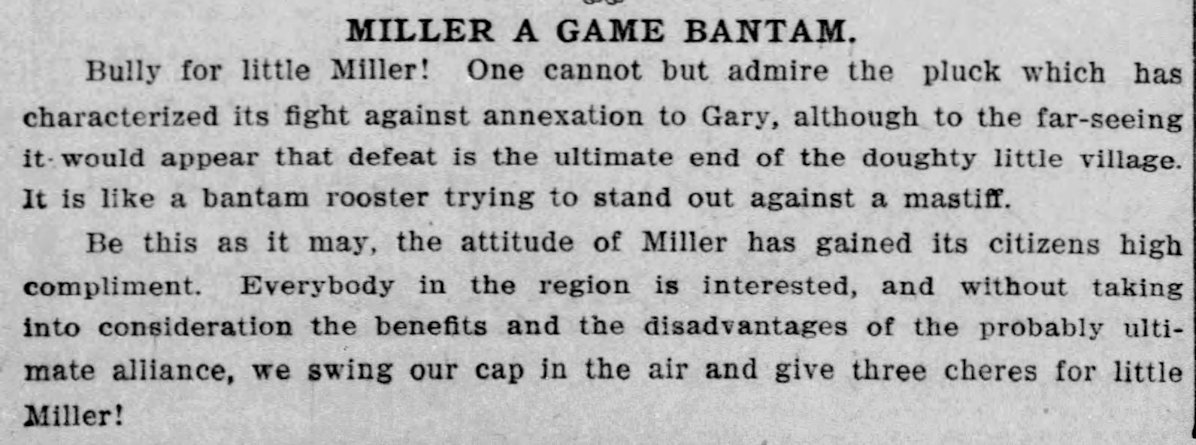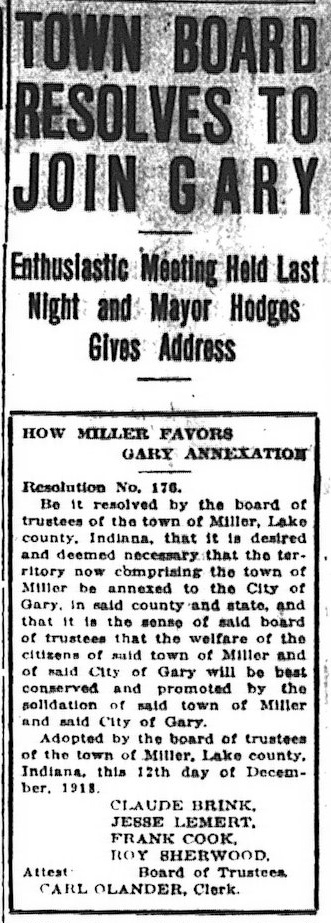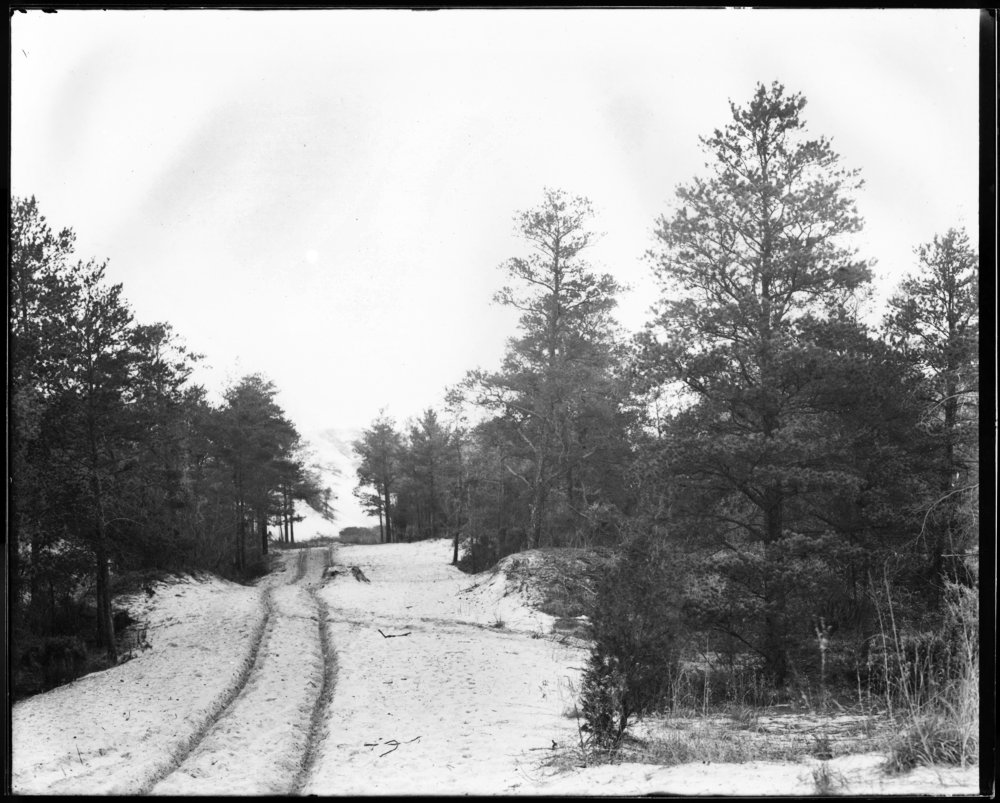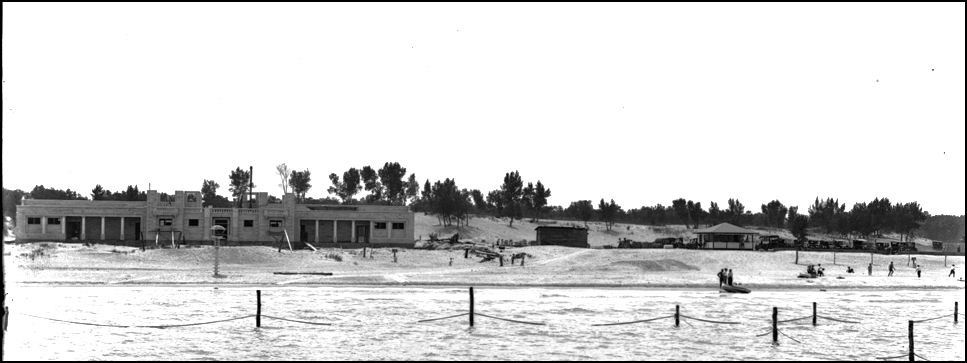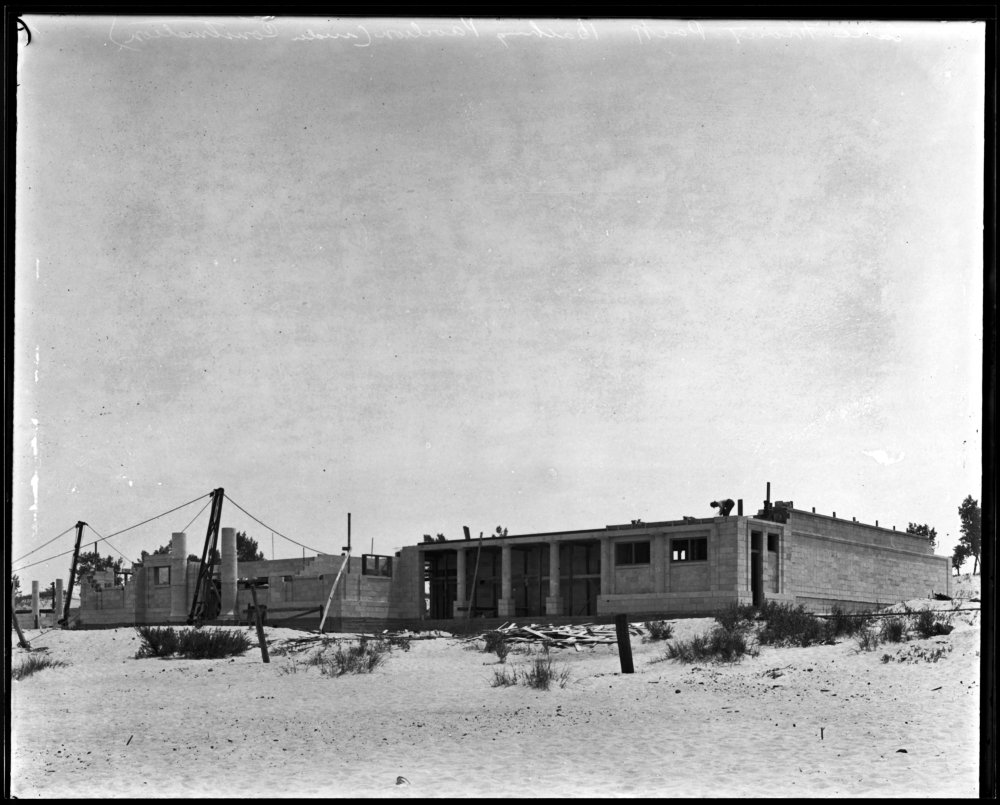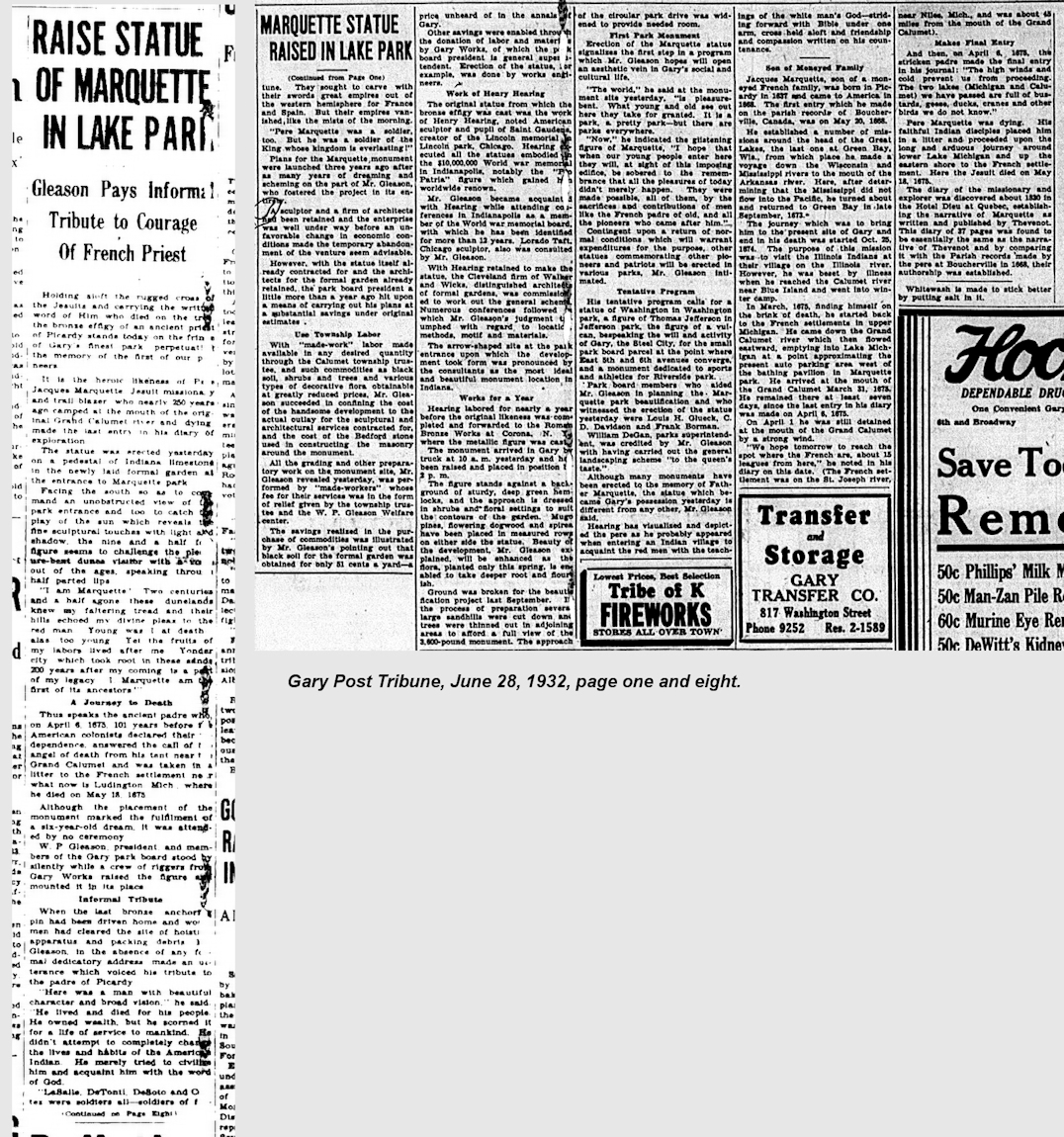“From Bog to Park – the Annexation of Miller and the Building of Marquette Park”
The history of Marquette park is entwined with the history of the annexation of Miller. It is difficult to separate them; ultimately the securing of a park on the lake front depended on the annexation of the town. This is that story as told through newspapers of the day, the Hammond Times and the Gary Daily Tribune. Few official documents remain, but the timeline of events can be reconstructed through newspaper articles. A brief timeline is provided here as well as a narrative of the details. Milestone articles can be read by clicking on the headlines, but I have a number of other articles collected from the microfilm. Feel free to contact me using the email at the end for clarifications or additional details.
"Well, all I know is what I read in the papers." - Will Rogers
Be sure to check out the companion maps page.
Gary tries to buy the land - 1911
Ten months later a new scheme was proposed by Gary Alderman Maurice N. “Battleaxe” Castleman. As a member of the park board Castleman suggested spending half a million dollars to buy the land for a park. The Hammond Times pointed out that it would probably bankrupt the City or at very least leave no money for other park developments. During an inspection of the site in June of 1911 Castleman was asked how the people of Gary would reach the site. “Don’t yew worry about that,” said Alderman Castleman changing the navy plug from one side of his mouth to the other. “This year park will be reached by an interurban railroad in less time that it takes ter think, just as soon as the lad is purchased. We will have trolley cars and airships running every five minutes for the benefit of the ‘peepul’ who wish to while away the’r spare hours in this delightful reckreating center.” (sic-transcription exact).(Footnote: “Park Board Inspects Proposition,” Hammond Times, June 8, 1911, page 8. ) Castleman, one of those colorful characters of early Gary, would prove to be an anathema to Millerites until he was ousted from the Gary council a year later.
Castleman, who was elected to the council in November of 1909, resigned his position a year later then stole his resignation letter from the clerk’s files. After finally getting ousted in May of 1912 he announced for mayor in 1913. Jim Lane, in City of the Century, writes of Castleman: “Maurice N. Castleman personified the frontier spirit of Southside capitalists. Called “BattleAxe” because of his expertise in spitting a brand of chewing tobacco by that name, Castleman started out in Gary as a saloonkeeper and became a real estate speculator, trolley car executive, and city councilman. He amassed a fortune by combing the Crown Point land files and then buying out absentee owners acquiring title simply by paying delinquent tax assessments. Once, dressed in raggedy clothes, he bought a choice plot for ten dollars after telling an unsuspecting Chicago owner that the land was under four feet of water. He wanted it for duck hunting, he said.”(Footnote: Lane, James B. 1978. City of the century: a history of Gary, Indiana. Bloomington: Indiana University Press., page 35. ) In 1923 his divorced wife was looking for him, no one knew if he was dead or alive.(Footnote: “Is Castleman Dead or Alive,” Hammond Times, October 16, 1923, page 1. )
Despite a seemingly friendly joint meeting in the Miller Town hall on July 20th nothing would happen for another year. In the meeting Miller decided to proceed with condemnation of Drusilla Carr’s 50 acres (Footnote: In the newspapers, and in this article, the acreages mentioned vary until the final aquistions in 1919 and 1940. Land was contested, and Mrs. Carr had divested herself of some of it in payment to creditors. ) at the end of Lake avenue and then work with the park board to buy the rest of the needed land. Of course no one still had any idea of who owned the land and Drusilla’s land claim was in court – seemingly always in court.
A Coney Island for Miller - 1912
Two years after the court had declared that Gary could not annex Miller the question was up for grabs again.
While Castleman was still around wanting to buy the land, into the mix stepped William C. Crolius, a former mayor of
Joliet and the defeated Gary mayoral Democratic primary candidate in 1909.
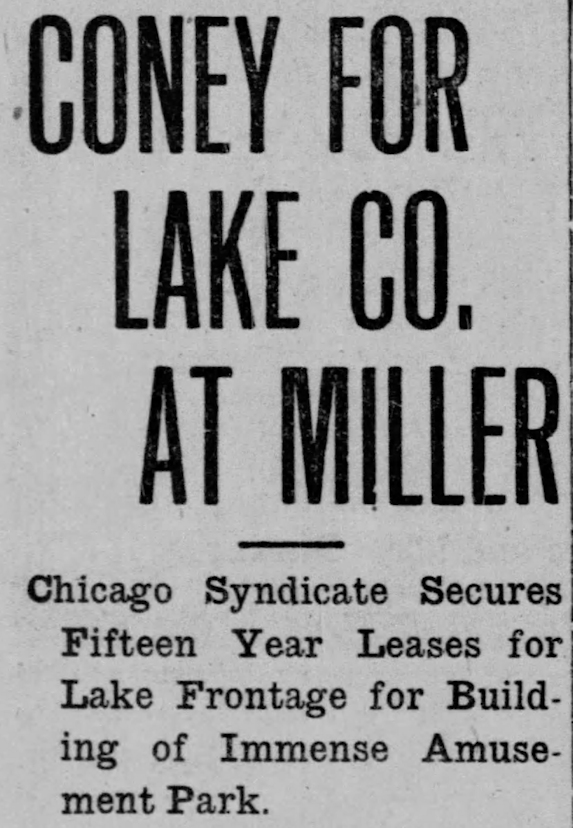 Crolius, who claimed that he had leased land
from Mrs. Carr for 15 years, offered detailed plans to build a pier and run boats between Chicago and Miller with his
managing partner, Captain Miles Barry, a former tugboat and steamship owner. The Daily Tribune pointed out that once in
Miller they might get stranded by a change of weather and the restaurants in Miller would flourish before they could return to
Chicago by train. The folks in Miller loved the idea and had been bullied by Castleman one too many times.
Crolius, who claimed that he had leased land
from Mrs. Carr for 15 years, offered detailed plans to build a pier and run boats between Chicago and Miller with his
managing partner, Captain Miles Barry, a former tugboat and steamship owner. The Daily Tribune pointed out that once in
Miller they might get stranded by a change of weather and the restaurants in Miller would flourish before they could return to
Chicago by train. The folks in Miller loved the idea and had been bullied by Castleman one too many times.
Crolius had made his grandiose plans public on May 8th. Eight days later the two parties vying for the land met in the Miller Town Hall. At the start Mayor Knotts and Crolius shook hands. Things got “warm” when Crolius started in on Castleman’s reputation, prompting outbursts on both sides: “Taking a big quid of tobacco Battleaxe fired volleys of the weed juice at the nearest spittoon and in a loud and screaming voice denounced Crolius as a schemer and the agent for real estate men. Mayor Knotts punctuated the proceedings with a few words which do not look good in print. They referred to his old time opponent, Crolius.” (Footnote: “Miller is Not to Be Cajoled,” Hammond Times, May 16, 1912, page 8. ) The Mayor and Castleman went home disgusted while the town trustees, North, Olander and Frederickson were congratulated by fellow Millerites for keeping the Gary park grabbers at bay. Crolius was their man, for the time being anyway.
The very next day Drusilla Carr won another round in court over 85 contested acres of what she claimed were hers’, more than 160 acres stretching from the mouth of the Grand Calumet (about where the Marquette Park concession stand is today) to the west line of U.S. Steel’s property. The land was reputedly worth in the neighborhood of two thousand dollars an acre, but the land in what is now Marquette Park was largely a bog by 1912 and not worth nearly as much as that at the north end of Lake Street.(Footnote: Again, the acreage is from the newspapers and basicly conjecture. With the reversal of the flow of the Grand Calumet by U.S. Steel the old mouth of the river, approximately where the concession stand in Marquette park is today, silted up with sand and decaying vegetation. Between that and the lagoon in the old course of the river the land was frequently wet. ) Almost immediately she filed an affidavit saying she had never leased any land to Crolius and wasn’t selling any land to anyone until her case in court was finally settled. The victory in May was only one chapter in the long dispute. The Gary Tribune crowed happily in an editorial that the land would now be available for purchase in the future, that Crolius was a four-flusher with nothing to his scheme, and it was time the City of Gary start cozying up to Mrs. Carr.(Footnote: “Site for Our Lake Front Park Is Safe,” Gary Daily Tribune, July 7, 1912. )
The Miller trustees lost total faith in Crolius rather quickly, especially after Drusilla’s affidavit. Crolius stuttered and stammered, claiming no lease was necessary and he could claim riparian rights. But then he failed to show up for meetings and by the end of the summer things were back to square one: no park, no annexation.
In December the Gary park board met and every one of the seven members had different ideas. A Gary park board member, The Daily Tribune’s president Homer Carr, thought the land worth about a thousand dollars an acre. Board chairman William Gleason said it wasn’t worth more than fifty bucks an acre and then was accused of wanting the land for U.S. Steel for another coal storage site. One source of happiness was the discovery they had $200,000.00 to spend, especially good news to board member Bill Cain, president of Cain Construction who benefited from park board contracts. No wonder the folks in Miller wanted to be left alone.(Footnote: “Tangle Promises No Speedy Solution,” Hammond Times, December 12, 1912, page 8. )
1914 - Hobart Township or Calumet Township? Who’s going to build the roads?
The question of annexation was again in the forefront in the summer of 1914, but this time it was de-annexation – from Hobart township. In a Times headline story subtitled, “Miller People Want a Divorce,” it was claimed by the folks in Miller that Hobart township was tapped out of money to build or improve roads and that Miller would never get Lake Street paved, let alone a new road along the Lake and Porter county line to the beach.(Footnote: “Hobart To Lose And Calumet To Gain,” Hammond Times, July 27, 1914, page 1 and 8. ) The county commissioners were presented with a remonstrance from Hobart and the annexation to Calumet township was deferred - until 1922 as it turned out.
For eight years Miller remained in Hobart township even after Miller’s annexation in 1919. When the City of Gary petitioned the county commissioners in January of 1921 to take Miller out of Hobart township and join it to Calumet township the commissioners declined to do so faced with another remonstrance petition from Hobart. What turned the tide a year later was Mayor Johnson urging the paving and building of “Gleason Road,” an extension of the Gary-Aetna Fifth Avenue up Lake Street and turning eastward to the Porter County line. Miller was taken out of Hobart township at the county commissioners meeting Monday, February 27, 1922.(Footnote: Hammond Times, March 1, 1922, page 1. "Gary residents who have been praying for the construction of the Gary-Beach Miller road can now rest at ease. When the old town of Miller was taken out of Hobart township by the county commissioners at Crown Point on Monday and annexed to Calumet township, they were assured an early construction of the much needed highway." ) Grand Boulevard, just a dirt road, had been opened in 1916 by the Town of Miller after two years delay thanks to the New York Central Railroad.
According to an article in the Times in June of 1915 the NY Central had opposed any road building north from the town hall (Grand Boulevard) because it wanted to build a yard along its tracks and didn’t want a road interfering. That all came to a head in March of 1915 when the railroad proposed to the town that it would pave Lake Street and build a new two thousand foot long road skirting the south bank of the Grand Calumet as long as the town shelved its plans to open the boulevard. When the railroad failed to provide their promise in writing it went to court where it was ruled in Valparaiso circuit court that Miller should go ahead with opening Grand Boulevard.(Footnote: “N.Y. C. RY. To Build Big Yards,” Hammond Times, March 30, 1915, page 1. And “Gary Wins Another Lawsuit,” Hammond Times, June 18, 1915, page 10. )
The Joint Park Board - 1915
Getting a park looked a little more hopeful when in March of 1915 the State legislature passed Senate Bill 165 which authorized the creation of joint park boards with the authority to levy taxes to the participating towns and cities. A joint park board of the Gary park board and Miller town trustees was formed in July.(Footnote: “Joint Board Started,” Hammond Times, July 24, 1915, page 2. )

So proclaimed the headline in The Times on October 7th. Glowing articles appeared in October papers around the state like the one in The Indianapolis News lauding steps taken by the joint Gary-Miller board to preserve 329 acres. Those came on the heels of a tour of the site by the joint park board in August. The one sentence notice in the Times of the August tour was just below another note: “Attorney E.G. Ballard of Chicago, formerly of Chicago, was in town yesterday renewing old acquaintances.” Ballard, Drusilla Carr’s attorney who would fight annexation to the last, no doubt visited a worried Mrs. Carr.(Footnote: Hammond Times, August 14, 1915, page 5. )
Indeed, on November 3rd the court issued a restraining order stopping the joint board’s plans to set aside the 329 acres of land for a park.(Footnote: “Court Order is Issued,” Hammond Times, November 4, 1915, page 6. ) Mrs. Carr, represented in court by Attorneys Ballard and Carver, had thrown a monkey wrench into the plans. A hearing was set for November 10th, but then hearings do have a way of getting postponed. In December the joint board met to lay out assessments but did little – a judge hadn’t been selected to try the case yet.
In any case, damper would hang over the board for another two years: a court ruled that only elected bodies could levy taxes, thereby eliminating the ability of the joint board to raise money. It wasn’t until two years later that the supreme court ruled that indeed the “Gary-Miller joint park board, although an appointive body has the constitutional right to impose a tax for the purposes for which it was created.”(Footnote: “Hardy Is Reversed by Court,” Hammond Times, February 15, 1917, page 2. )
A New Coney Island Scheme - the hot summer of 1916.

Then in April of 1916 things warmed up again when promoters got the ear of Mrs. Carr proposing to spend a million and a quarter dollars to acquire her land, then mentioned as 240 acres, to build an “Atlantic City” with a summer Palm beach hotel, a great bathing beach, an island pavilion and a harbor way for excursion boats. At their June meeting the town trustees came out for annexation vowing to hold a mass meeting and circulate a petition. Mayor Johnson of Gary was initially opposed to annexation saying there was no real tax advantage to the City, but with annexation the city would be able to condemn land and build a park. The people of Miller were, however, very suspicious of annexation, citing increased taxes to them, contracts which would be let to cronies of the “Gary gang,” and an influx of saloons and undesirables to the town limits. (Footnote: “Miller Against Annexation to Gary Just Now,” Hammond Times, June 28, page 2. )
July and August were hot in more ways than one. A heat wave gripped the country, killing 44 people in one day in Chicago, July 28th, a day the temperature recorded 104 degrees in Gary. Thousands of people used the beach and the mosquitoes were described as “man-eating”
in the marshes of Aetna and Miller. In the midst of this the City of Gary put a “full court press” on the people of Miller by passing a $200,000.00 bond
issue to build a park should the people of Miller either de-annex the desired land or agree to total annexation. On August 24th a mass meeting to hear speeches was held
in “…the dusty street before the school house in Miller.” In the next day’s reporting on the meeting the Daily Tribune also ran an article, and an editorial, claiming that the “Coney Island”
scheme was a vile syndicate which would bring more saloons and mayhem to Miller. Without naming names it claimed a Chicago attorney and two Miller men were behind the syndicate,
implying that the Chicago attorney was E.G. Ballard, Mrs. Carr’s lawyer. (Footnote:
“Miller Beach Sought As Prey of Tenderloin,” Gary Daily Tribune, August 25, 1916. And “Only Possible Outcome,” Daily Tribune, editorial.
)
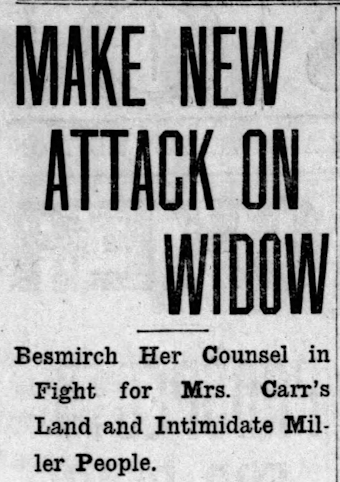
The Hammond Times rejoined the next day writing that the people of Miller were not surprised at the intimidating attacks on Ballard or Mrs. Carr by the Gary newspapers and wonder what will come next. Homer J. Carr, after all, was both the president of the Daily Tribune and a member of the Gary park board. (Footnote: Homer Carr was not any apparent relation to Drusilla per The Carr Family of Miller, Lake County, Harmening, Clara B., 2010, privately printed. ) Meanwhile, that same week, the lawyers were sharpening their pencils at superior court in Michigan City as the Hitt-Hall interests, which had lost 80 acres of land to Mrs. Carr in 1912, filed suit to have that judgement thrown out. Drusilla’s land had dwindled to less than 50 acres as she paid her lawyers with land. While the court papers from the original suit in 1903 were lost, the new suit was based on an affidavit filed by the then deputy sheriff John Agnew saying that he had served Mrs. Carr a summons in 1903. Mrs. Carr claimed there was no written proof of that and besides, she had claim by adverse possession having lived on it for more than 20 years. The tangled mess would be in the courts for years.
After a hot summer of charges and counter-charges things cooled down. The news of the war in Europe dominated the papers the winter of 1916-1917. With America’s entry into World War One in April of 1917, the mills and the powder plant in Aetna working to capacity, things stalled until the war was over.
In November of 1916 the town board was able to acquire the rights to build a boulevard from the north end of Grand Boulevard eastward along the lake to the county
line. The town had opened Grand Boulevard and Forest west (now interrupted) to Lake Street and all that was needed was to improve those roads. (Footnote:
“Win Lake Front Drive and Park East of Miller,” Gary Daily Tribune, November 15, 1916. Click for full article:
“Win Lake Front Drive and Park East of Miller”
)
Things, however, remained static for the joint park board until February, 1917 when the supreme court ruled that the board could indeed levy taxes, the legislation of
1915 being constitutional. Once again there was a possibility of a joint park board. After a new visit to the site in November of 1917, the Times
crowed “A Park Victory for the People” in a short editorial: “The Gary-Miller joint park board, now free from the baneful influence of the legal and political department of
Wall street, has moved to get the people a lake front beach at Miller. This deal is about to be consummated.
With a board made up of the Miller trustees
and the new commissioners named by Mayor Johnson, the five years of stalling of Carr, et al. is show up. In the hands of the people the park board is now doing something.” (Footnote:
Hammond Times, December 4, 1917, page 4.
) It was still unclear if the joint park board could do anything or if it was even legal.
Annexation
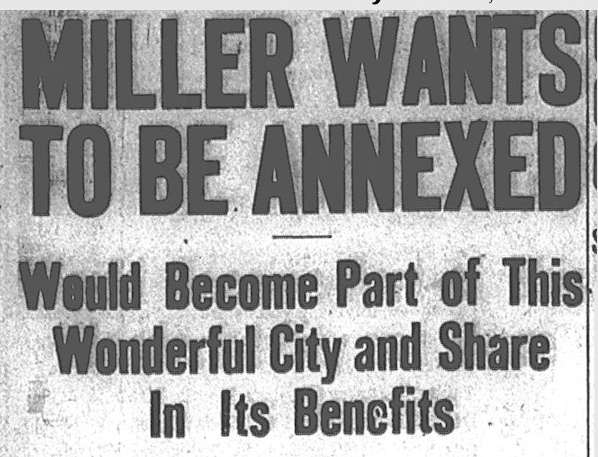
The mayor and council of Gary were somewhat astounded when they learned that, seemingly out of the blue, the council would be presented with a petition, signed by some 200 Miller property owners and voters, at its December 17, 1918 meeting requesting annexation to Gary. The reality was that Miller, bonded to the hilt, could not pay for repairs to existing sidewalks, had shelved buying a wagon to pick up garbage for lack of funds, and could barely afford to resurface dirt streets with cinder; it was broke. A canvas of the town by a Tribune reporter on the 12th failed to find one real objector to the annexation. (Footnote: “Annexation Will Bring Improveme’t,” Gary Daily Tribune, December 11, 1918. And “Miller Folk in Favor of Annexation,” Gary Daily Tribune, December 13, 1918. ) Mayor Hodges addressed a “get-together” meeting at the town hall on the 12th and was presented with resolution #176 signed by the town trustees. (Footnote: “Town Board Resolves to Join Gary,” Daily Tribune, December 13, 1918, page 1. ) Gary’s city council took up the matter at its Monday night meeting on the 17th, accepting Miller’s petition and referred the matter to the ordinance committee. The Carr family, and attorney Ballard, filed a remonstrance on January 10, 1919. After the second reading of the ordinance she and her family withdrew it formally on February 10th, leaving Ballard as the sole remonstrator, and he withdrew shortly before it was to come to trial on Friday, February 14th, the Times reporting that Ballard “…was the only one of the remonstrators left…opposition to the Miller annexation to Gary was largely through the efforts of Ballard who in a sensational complaint attacked the U. S. Steel Corporation, Gary Land Co., and almost everything else under the sun." (Footnote: “Annexation Case Has Fallen Out,” Hammond Times, Saturday, February 15, 1919. )
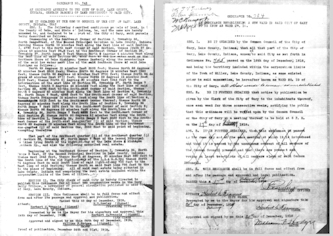
At its Monday, February 17th meeting the council formally passed Ordinance 754 and presented it to the mayor for his signature making Miller Ward 10 of the City of Gary.
Lake Front Park Becomes a Reality - 1919-1922
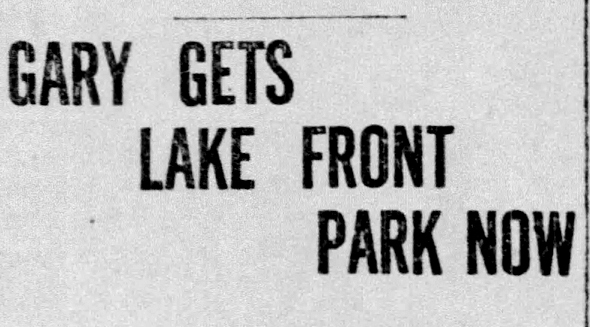
Once annexed, U.S. Steel proudly donated the land necessary for Marquette Park to the city at the August 29, 1919 meeting of the Gary park board. The 116 ½ acres valued at half a million dollars, was supposedly “a complete surprise” according to the article in the Hammond Times, which also said that the “…corporation has been working for some time to close their deal in their effort to furnish Gary with a lake side recreational park.” (Footnote: “Gary Gets Lake Front Park Now,” Hammond Times, August 30, 1919, page 5. ) That acreage corresponds to the tract of the east portion of Marquette Park owned by the city as shown on the companion map page. I imagine that U.S. Steel acquired the land by negotiations with Mrs. Carr, used its legal power to clear title on some of it, and bought the rest from existing estates. The acreage west to the steel company’s property line and claimed by Mrs. Carr was left alone for the time being. Title to that land would be contested in the courts until the 1940’s.
There was very little news of the park in 1920 except that Homer Carr and William Gleason had a huge spat over how improvements were to be made, the fight which lasted several months spilled over to animosity with Mayor Hodges. (Footnote: [“Mayor Cuts Diplomatic Relations – Gary Executive Angered at Newspaper and Park Bd. Row Goes Merrily On,” Hammond Times, September 23, 1920, page 1.] ) In any case, the architectural firm of George W. Maher and Son was no doubt busy drawing plans for the bathhouse which would go out for bid in February of 1921.
Ambitions for the park were high in February of 1921. At a park board meeting its president, William P. Gleason, figured the bathhouse could be built for
seventy-five thousand dollars. His plans included a paved boulevard leading to the park and extending east to the county line.
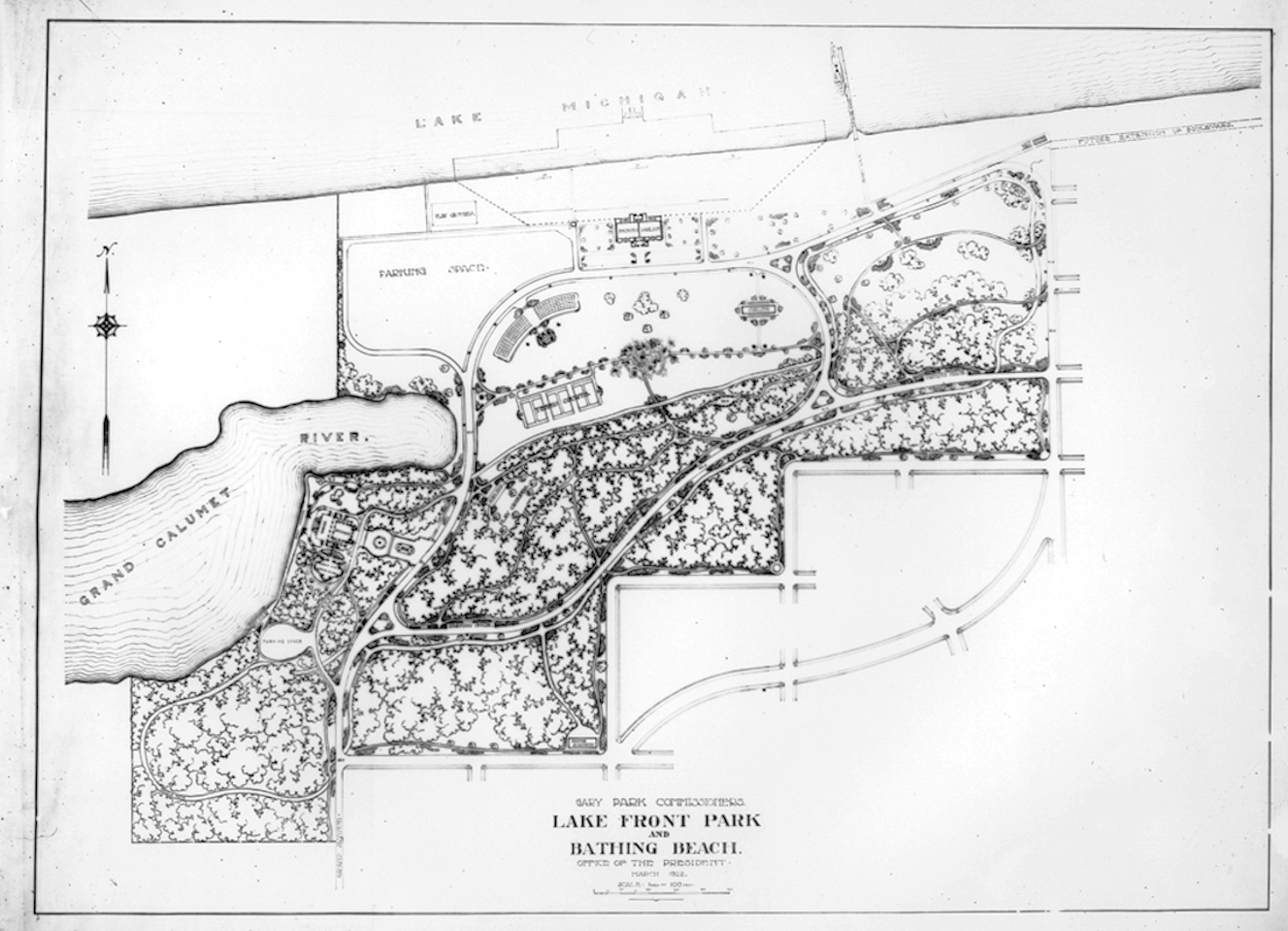 It was likely in March that the conceptual drawing of the park was made, for having gotten bids for the bathhouse higher than expected,
the road east was shelved as a future project in favor of a loop within the park, (Footnote:
“Lake Shore Drive Halted,” Hammond Times, March 24, 1922, page 5.
)
but parking for at least five hundred automobiles was included. The concept plan shows also the pavilion, a band shell and tennis courts.
It was likely in March that the conceptual drawing of the park was made, for having gotten bids for the bathhouse higher than expected,
the road east was shelved as a future project in favor of a loop within the park, (Footnote:
“Lake Shore Drive Halted,” Hammond Times, March 24, 1922, page 5.
)
but parking for at least five hundred automobiles was included. The concept plan shows also the pavilion, a band shell and tennis courts.
In late winter and into the summer things moved fast. When bids for the bathhouse, expected to cost $75,000.00, were opened at the board meeting Monday,
February 21, 1921 the “…commissioners were staggered by the high estimates submitted.” (Footnote:
“City Bathing Pavilion to be $125,000.00,” Gary Tribune, February 22, 1921, page 2.
)
 Bids were for the building to be “Hydrastone” (Footnote:
Hydrastone, or concrete block, had become popular in the first decades of the 20th century as machinery for
its manufacture developed. The two-piece construction, while different, was not unheard of. For more about the history of concrete block see
Hall, James,
"The early developmental history of concrete block in America"
)
or brick, but with little difference in price the contract was awarded the following Friday
to the Nash-Dowdie Company of Chicago for hydrastone with plumbing contracts, signed March 7th, going to a local Gary firm. The specification said that the building
would be ready to use in late June, four months away. (Footnote:
Sorry, but as a former project manager, and the manager for the adaptive reuse of the Aquatorium's east wing in 2000, I can't help but laugh at this.
) The contractor said he would begin construction the next week. (Footnote:
“Start Gary Bathing Pavilion Next Week,” Hammond Times, March 8, 1921, page 5.
)
Bids were for the building to be “Hydrastone” (Footnote:
Hydrastone, or concrete block, had become popular in the first decades of the 20th century as machinery for
its manufacture developed. The two-piece construction, while different, was not unheard of. For more about the history of concrete block see
Hall, James,
"The early developmental history of concrete block in America"
)
or brick, but with little difference in price the contract was awarded the following Friday
to the Nash-Dowdie Company of Chicago for hydrastone with plumbing contracts, signed March 7th, going to a local Gary firm. The specification said that the building
would be ready to use in late June, four months away. (Footnote:
Sorry, but as a former project manager, and the manager for the adaptive reuse of the Aquatorium's east wing in 2000, I can't help but laugh at this.
) The contractor said he would begin construction the next week. (Footnote:
“Start Gary Bathing Pavilion Next Week,” Hammond Times, March 8, 1921, page 5.
)
The bids had been published without really knowing whether there would be a road to the beach or not, for in January the county commissioners were balking at spending $390,000.00 to extend, and pave, a road from Aetna through Miller to the bathhouse and east to the county line, a road commonly called “Gleason Road.” The Gary park board commissioners were nevertheless excited to advertise for bids: “We will get the material to the Lake Front if we have to carry it through the sand and jungles on our back.” (Footnote: “Will Build Bath House Anyway,” Hammond Times, January 29, 1921, page 1. ) “Gleason Road,” which was essentially the paving of Lake Street, was not accomplished until 1923. The park board, along with many residents of Gary and Miller, petitioned the county commissioners in March of 1922 to pave some 2 ½ miles of roadway from Aetna to the north end of Lake Street. (Footnote: "Notice of Petition," Hammond Times, March 23, 1922, page 15. )
By April 8th it was said that work on the bathhouse was progressing rapidly and the cinder road to it was completed as well as Grand Boulevard being repaired. “Thousands of Garyites and out-of-town visitors sought the cool waters and breeze of Lake Michigan at Miller beach yesterday and today all beaches along the lake report record breaking crowds,” read the Hammond Times on June 23rd. Things slowed though, the contractor announced that it wouldn’t be done this season and then in August some plumbing fixtures were stolen from the site. A contract to Willis Slosson of Gary was awarded to remove a 25,000 cubic yard dune “near the new Gary bathing pavilion” and black dirt, 5,000 cubic yards of it, was brought in in the fall and winter of 1921-1922. (Footnote: (Dune removal and black dirt) Hammond Times, July 13, page 5. AND “Legal Notice,” Hammond Times, September 30, 1921, page 5. Bids due to the park commissioners October 10 for five thousand yards of black dirt. )
Lake Front Park to Marquette Park, 1922-1928

“Ten thousand people visited Gary beach and Miller beach yesterday and hundreds of them went into the water despite the fact that Lake Michigan was lashed to anger by a stiff northerly breeze…A special excursion train on the New York Central brought 1,200 Chicago Sunday excursionists in a body. The train debarked them at Miller station and the entire crowd, men, women and children footed it to the beach, nearly a mile distant. Lake avenue was crowded with excursionists and the cars and busses were forced to give the pedestrians the right of way. Street commissioner Louis Spiro had his men and teams out all day sprinkling Lake and Forest avenues leading to Gary and Miller beach and there was a distinct relief from the dust.”
So read the story in the Tribune the day after the bathhouse formally opened on Sunday, June 18, 1922. Saturday a very descriptive page one article (Click the above headline) had heralded the opening by saying that a great throng was expected and that a thousand bathing suits will be available for those who come "without the necessary article." The article also said that "Gay Mill Gardens at the entrance to Miller beach is also ready to do its part in entertaining the beach-going public." I can only imagine what it did for their business. The article also goes on to say that Judge Gary had visited the bathhouse the previous Thursday and “unhesitatingly pronounced it one of Gary’s greatest assets.”
In April of 1923 the common council voted a hundred and fifty-thousand-dollar bond issue for improvements to the park. In the meantime, “Gleason Road” was being built, opening in early June with the contractor working on the northern and eastern end of the road.
Lake Street paving. See additional picture on the maps page.
The paper describes it as “from the new Aetna crossing to the B. & O tracks at Miller…” and the northern end as “extending from the B. & O. crossing to the Lake Front Park.” The Gay Mill advertisement of June 30th in The Times includes the line, “The new cement road is now open to traffic.”
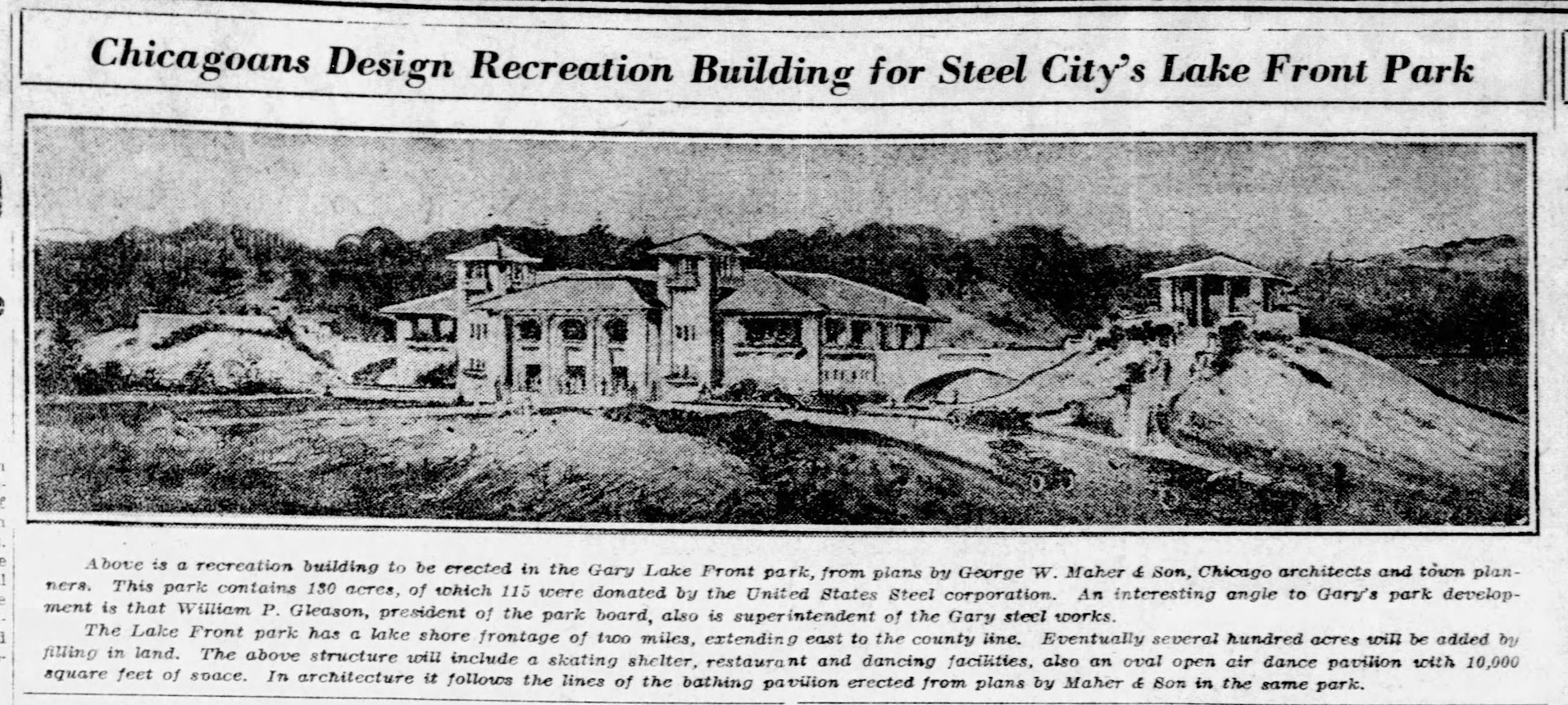 Heady times indeed for the little town of Miller. On November 11, 1923 the Chicago Tribune printed the conceptual drawing of the new “recreation building” to be
erected at Lake Front Park. Built over the next year, it was definitely open by August 29th when the Gary board realtors hosted
300 visiting real estate men from around Indiana. (Footnote:
“Park To Be Garden Spot of Indiana,” Hammond Times, August 23, 1924.
)
When Gleason announced in March of
1925 that two hundred sixty-eight thousand dollars would be spent on park improvements in the city it would include the addition of 17 acres to Lake Front Park. (Footnote:
“Will Spend $268,000 Improving City Parks,” Hammond Times, March 14, 1925, page 5.
)
In August of the same year a $104,000.00 bond issue was purchased for
construction of “Gleason Road No. 4, which will provide a new entrance into Lake Front Park at Miller by the way of Grand avenue.”
Exactly what that refers to I don’t know other than it may have meant the paving of Grand Boulevard as the main entrance to the park was
provided from Lake street down Forest, now interrupted. In 1924 the Gary Street Railway even announced plans to run its
line down Grand Boulevard to Hickory then along Hickory to Montgomery to Maple and then eastward to the eastern limits of Gary. (Footnote:
“Notice,” Section II, Hammond Times, April 26, 1924, page 12.
)
Of course, it never happened; the automobile won out.
In September of 1925 the park board crowed that since June 7th nearly 50,000 people had passed through the showers and at least 100,000 people
who did not go bathing visited the park.
Heady times indeed for the little town of Miller. On November 11, 1923 the Chicago Tribune printed the conceptual drawing of the new “recreation building” to be
erected at Lake Front Park. Built over the next year, it was definitely open by August 29th when the Gary board realtors hosted
300 visiting real estate men from around Indiana. (Footnote:
“Park To Be Garden Spot of Indiana,” Hammond Times, August 23, 1924.
)
When Gleason announced in March of
1925 that two hundred sixty-eight thousand dollars would be spent on park improvements in the city it would include the addition of 17 acres to Lake Front Park. (Footnote:
“Will Spend $268,000 Improving City Parks,” Hammond Times, March 14, 1925, page 5.
)
In August of the same year a $104,000.00 bond issue was purchased for
construction of “Gleason Road No. 4, which will provide a new entrance into Lake Front Park at Miller by the way of Grand avenue.”
Exactly what that refers to I don’t know other than it may have meant the paving of Grand Boulevard as the main entrance to the park was
provided from Lake street down Forest, now interrupted. In 1924 the Gary Street Railway even announced plans to run its
line down Grand Boulevard to Hickory then along Hickory to Montgomery to Maple and then eastward to the eastern limits of Gary. (Footnote:
“Notice,” Section II, Hammond Times, April 26, 1924, page 12.
)
Of course, it never happened; the automobile won out.
In September of 1925 the park board crowed that since June 7th nearly 50,000 people had passed through the showers and at least 100,000 people
who did not go bathing visited the park.
At the dedication dinner of the new City Hall on December 17, 1928 park board president William Gleason announced, among other things, that Lake Front Park would be renamed Marquette Park, the name used then on in newspaper articles. (Footnote: “Gary Dedicates New City Hall Building Yesterday,” Hammond Times, December 18, 1928, page 23 continued from page 1. )
The Father Marquette Statue - 1932
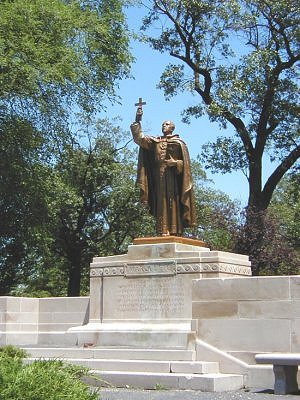
During the noon hours of June 27,1932 William Gleason’s “baby,” the statue of Fr. Marquette, was raised by engineers of the works department. Conceived of some six years previously but delayed by the Depression, the site had been prepared over the previous year with the help of the Calumet trustees and labor exchanged for relief from the trustees and Gleason’s own Welfare center. Soil and landscaping materials were obtained at cut-rate prices and the only real outlay was to the architects, sculptor and the Bedford stone (Footnote: “Bedford stone,” described as such in the newspaper article, is and was a common name for Indiana limestone quarried in south central Indiana by the Bedford Stone Quarries Co., of Bedford, Indiana. See an article in quarriesandbeyond.org for more information. ) used in the monument’s base.
While the Cleveland firm of Walker and Weeks had been hired to design the layout, the statue itself was executed by Henry Hering in New York City and cast in the Queens neighborhood of Corona. It had arrived by truck on the 27th and raised immediately. Hering was well known for his sculptures at the Indiana World War Memorial Plaza, also designed by the firm of Walker and Weeks. (Footnote: Wikipedia article on the War Memorial Plaza. )
For a bit more information about Henry Hering (1874 - 1949) and the statue see my earlier page on Marquette Park.
The Rest of the Park
It would be 22 years after the initial acquisition of the 116 ½ acres in August of 1919 that the city would acquire the 65½ acres which add to Marquette park.
The 65½ acres in the City of Gary tract (Footnote:
Lake County parcel number 45-05-31-201-001.000-004 that extends from just west of the current parking lots to just west of Lake Street
beach and south to the Old Indian Boundary line, the imaginary east-west line just south of the old Naval Reserve parking lot. See the companion
map page. )
were hotly contested over those
22 years by Drusilla Carr and her heirs. That contest actually stretched back to 1903, but by 1940 it involved 88 acres that the Gary Land company had paid
taxes on and which the courts had ruled, off and on, belonged to the Carr family. Drusilla Carr had paid off her attorneys in parcels of that 88 acres to the
point where her heirs owned only about 43 acres, but the Gary Land company held a lien on the 88 acres. While the details of this dispute, which was in court
almost yearly from 1903 to 1940 are too involved to go into, suffice it to say that prospective buyers at a tax sale in January of 1940 were thwarted, and disappointed, by the
court ordering the sheriff to sell the 88 acres to the Gary Land company for $92,632.00. The Land company then sold the land to the City of Gary for about that
amount. (Footnote:
“Sheriff Sells Carr Tract in Face of Order,” Hammond Times, January 26, 1940, page 2. AND Editorial, Hammond Times, July 20,1941, “The City of Gary has acquired
another mile of lake front just west of Marquette park and will preserve it in its natural state.”
Measuring on Google maps shows that it is a mile from just west of the parking lots, the old west border of Marquette park, to what was the east border
of U.S. Steel property.
The National park system acquired another 0.4 of a mile west to the north-south breakwater. Some 20 acres of that 88 acres was eventually acquired by the
National park system for what is the northern portion of Miller Woods.
View this area on Google Maps
)
In what seemed like a last-ditch effort, the Drusilla Carr Land company filed a one and one-half million dollar “slander of title” suit in December of 1940 claiming that for 28 years the Gary Land company, U.S. Steel, and others conspired to obtain the land by blocking others attempting to buy the land. A Porter County superior court judge took arguments under advisement in May of 1942, but I’ve found nothing more in the newspapers about that case so far. Following World War Two the Naval Reserve Training Center was built in 1949, officially commissioned in March of 1950.
A very great number of events have occurred in Marquette Park over the years, including my son’s wedding and my brother's, but chronicling them will have to wait for further research. In brief, there was a huge stage built in the lagoon for the 1931 Silver Jubilee, the installation of the Father Marquette statue, a dedication of the granite stone honoring Octave Chanute in 1936, a major do-over of the park with WPA money in 1936 which included the building of the municipal gun club house, the building of the bridges over the lagoon, the 1996 centennial celebration of Chanute’s flights, and the major upgrade in 2012. In searching “Marquette Park” in the papers I’ve been saddened by yearly reports of drownings, sometimes in the lake and sometimes in the lagoon.
According to the Aquatorium’s website timeline, the bathhouse which opened with such a flourish in 1922 (timeline says 1921) was remodeled in 1953 for inexplicable reasons destroying the original balustrades and capstones and contributing to the general deterioration of the building. In 1971 it was closed by the city and continued to deteriorate for 20 years until through the efforts of two civic leaders, Greg Reising and George Rogge, the “Society for the Restoration of the Gary Bathing Beach Aquatorium and Octave Chanute’s Place in History” was formed and over the next two decades the bathhouse was restored for adaptive reuse. It, the Pavilion, and the Kids Park continue to be the centerpieces of Marquette Park.
Resources and links:
Resources are mentioned in the text or the footnotes. The Hammond Times articles were accessed through newspapers.com. The Daily Tribune and Tribune articles were taken off the microfilm at the Lake County Library.
Links:
- The Friends of Marquette Park for ongoing efforts to maintain and upgrade the park and its kids park.
- A way to donate to the efforts of the Friends of Marquette Park.
- The Aquatorium's website. or The Aquatorium's Facebook page.
- The City of Gary's website for the Pavilion.
There are several other pages on this website, created back in 1995, which need updating, including the Kids Park page where you can buy a paving brick to memorialize a loved one, or yourself, to support the Kids Park.
Photo credits:
- Night-time photo of the Father Marquette statue courtesy of my brother Jim.
- The 1922 concept plan and the photos of the driveway and the construction of the bathhouse are from the Calumet Regional Archives' contribution to the Indiana University Libraries' Digital Library Program's U.S. Steel Gary Works Photograph Collection, 1906-1971.
- Photo of Lake Street paving and "East End Calumet River - Miller, Ind" from Clara Harmening.
